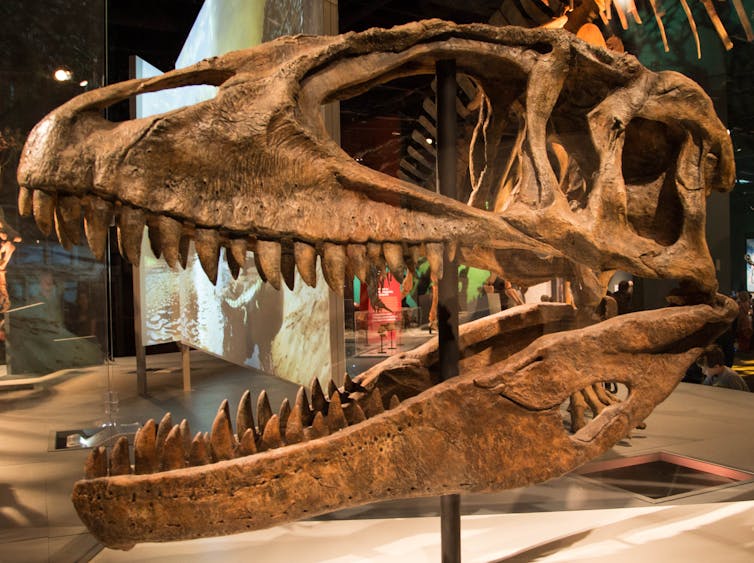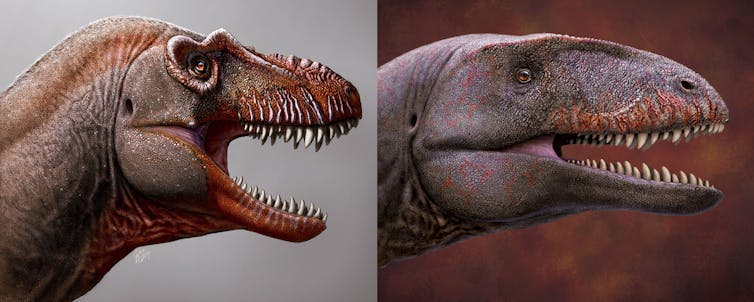
The top predator of the Jurassic and Cretaceous landscapes was usually a species of meat-eating dinosaur. These predators walked on two legs, had powerful jaws lined with sharp teeth and included species from groups known as tyrannosaurs, spinosaurs and carcharodontosaurs.
Tyrannosaurus rex, the goat-eating, jeep-chasing tyrannosaur from the movie Jurassic Park, was the apex predator of North America just before dinosaurs went extinct at the end of the Cretaceous Period. Although iconic, T. rex was only one species of many large, meat-eating dinosaurs that dominated various ecosystems at different times over the 130 million years of dinosaur reign.
During the Cretaceous Period, most species of top predator that evolved in North America and Asia were either carcharodontosaurs (shark-toothed dinosaurs) or tyrannosaurs (tyrant dinosaurs). The earlier part of the Cretaceous was ruled by carcharodontosaurs, after which tyrannosaurs replaced them as the top predators until the end of the Cretaceous.
New species
Recently two new species of these large Cretaceous predators were discovered — a tyrannosaur from Canada and a carcharodontosaur from Uzbekistan. I was lucky enough to be involved in the study of both. These two discoveries, although unrelated, have some interesting parallels.
In 2019, paleontologists Jared Voris and Kohei Tanaka — both who had trained in my lab at the University of Calgary — visited museums to look at fossils housed in collections. Voris went to the Royal Tyrrell Museum in Drumheller, Alta., and Tanaka to the State Geological Museum in Uzbekistan.
Each found a fossil specimen they thought may have been important, although overlooked. Both fossils had been found in Cretaceous age rocks of their respective region, and had sat in the museum collections for at least a decade without much notice.
After many months of study, each of these fossils turned out to be an entirely new species of meat-eating dinosaur, previously unknown to science. This meant that we would need to formally describe them, and each would be given its own species name.
We named the new tyrannosaur species Thanatotheristes degrootorum, which means “reaper of death.” The name draws inspiration from its predatory role in the 80-million-year-old ecosystem and for the first discoverer of the fossil bones, an Alberta rancher called John DeGroot.
On the other hand, we named the carcharodontosaur species Ulughbegsaurus uzbekistanensis after Ulugh Beg, a historical figure and early astronomer in Uzbekistan.

Top predators
The two species are known from only a few skull bones, with the remainder of their skeletons completely unknown. The most recognizable bones are from the jaws — the upper and lower jaw of Thanatotheristes and the upper jaw of Ulughbegsaurus.
From the jaws, it was apparent both species were a respectable and similar size. We were able to figure out their body size from these preserved bones. Measuring from the tip of the snout to the end of the tail, both species would have been around eight metres long — the length of the average school bus.
In these two studies, we discovered that Thanatotheristes and Ulughbegsaurus were each, by far, the largest predator of their ecosystems. The previous absence of a large predatory species in either ecosystem before was puzzling, as populations of large plant-eating dinosaurs would likely have grown unchecked, as in living herbivores.

Most other known predatory species from these ecosystems were small, typically less than three metres long. In fact, the older Uzbekistan ecosystem was also home to a small tyrannosaur species that was dwarfed by the large Ulughbegsaurus.
The rise and demise of top predators
Around 90 million years ago, all carcharodontosaur species went extinct – Ulughbegsaurus was among the last of its kind. Their extinction left a vacancy in North American and Asian ecosystems for new, large predators to evolve and take over. The tyrannosaurs, which for the most part, were knee-high to a carcharodontosaur for tens of millions of years prior, finally made their play.
Somewhere between 90 and 80 million years ago, tyrannosaur species began to evolve towards a larger body size. Thanatotheristes was one of the earliest species of these large tyrannosaurs, living around 80 million years ago in Alberta’s prehistoric past.
Thanatotheristes and its kin were among the ancestors that led to even larger tyrannosaur species, like the 12 metre long Tyrannosaurus rex. These large species went on to rule Cretaceous ecosystems of North America and Asia for the last 10 million years before the mass extinction event that wiped out the dinosaurs.
Darla K. Zelenitsky, Associate Professor, Dinosaur Paleobiology, University of Calgary
This article is republished from The Conversation under a Creative Commons license. Read the original article.











